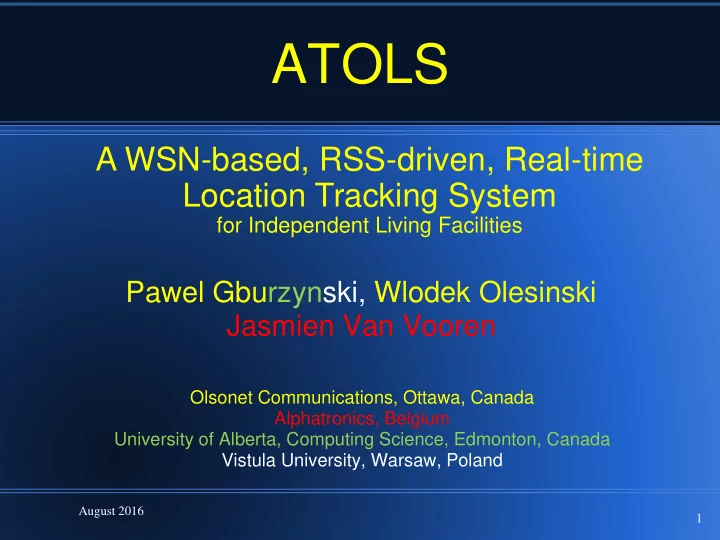

ATOLS A WSN-based, RSS-driven, Real-time Location Tracking System for Independent Living Facilities Pawel Gburzynski, Wlodek Olesinski Jasmien Van Vooren Olsonet Communications, Ottawa, Canada Alphatronics, Belgium University of Alberta, Computing Science, Edmonton, Canada Vistula University, Warsaw, Poland August 2016 1
Indoor Location Tracking Radio-based: TOA / TOF, TDOA / TDOF, AOA Phase Difference RSS considered passé these days Non-radio-based: Ultrasound, infrared, pressure sensors, active floor August 2016 2
Problem definition Estimate the location of people (and possibly other objects) wearing RF Tags. Coordinates in 3D Named places (within a building) A practical project: a system was already deployed, and we wanted to extend it with the new functionality … … in some preferably minimalistic way August 2016 3
Militza (Brugges) an Independent Living facility August 2016 4
Annonciaden (Antwerp) August 2016 5
What is a “location”? August 2016 6
The WSN: Tags & Pegs Tags implement some end functionality, e.g., sensing; a Tag can be mobile Pegs act as semi-infrastructure (e.g., static, devoid of sensors/actuators, used solely for communication) Pegs can be used as reference, e.g., for location tracking (if they do not move) Power considerations: Pegs can be powered from external sources, while Tags are battery powered The hierarchy is natural in many applications August 2016 7
Devices CC430F6137 (MSP430 + CC1100) 7cm 4 KB RAM 32KB flash BMA250 (accelerometer) August 2016 8
Devices August 2016 9
Devices: MSP430/CC1100 Small footprint, 4KB of RAM, 32KB for program (this is not a Java-friendly platform) Radio is ISM, highly configurable, (can be) integrated with the microcontroller, not BT Adjustable transmit power level, RSS measurable by the receiver August 2016 10
Software PicOS: Olsonet’s OS for tiny devices TARP/VNETI: Olsonet’s ad-hoc mesh networking scheme (no ZigBee) VUEE: Olsonet’s virtual development and testing platform for complete applications (praxes) August 2016 11
RSS is a crude attribute - high power - longer distance - fewer Pegs - cruder estimates - low power - shorter distance - more Pegs - finer resolution August 2016 12
Profiling / surveying Attempts at correlating RSS with distance via blanket functions don’t work too well Profile Sample : a vector of readings collected from a known location Tracking Sample : a vector of readings collected from a tracked device We can afford (relatively) many Pegs (say, tricky areas can be better covered, if that helps) August 2016 13
A floor in Annonciaden sample Peg 9 12 2 4 7 10 1 1 5 3 4 13 8 5 3 2 6 11 tricky locations can be split internally August 2016 14
Location bursts Tags emit “bursts” of 32 short packets transmitted at increasing power levels [in groups of 4]: . . . PL 0 PL 1 PL 7 Pegs receive what they can and forward the corresponding RSS vectors to the master. August 2016 15
A profile sample Peg # loc 1'0'2, att 5 "23-Jul-2016 19:59:03 ” power level 3 0 0 0 61 68 77 90 95 4 0 57 66 76 85 94 105 112 5 0 60 70 79 88 96 108 115 6 74 83 92 102 111 119 131 138 7 82 89 99 109 118 125 137 145 8 75 84 93 102 111 119 132 138 9 82 91 100 109 119 126 139 145 11 0 0 0 69 77 85 97 104 12 0 0 0 0 0 60 73 80 P0 P7 August 2016 16
A tracking sample ... ... looks similar, except that the location isn’t known Vectors arrive individually, the estimator can use any set of three or more vectors to attempt an estimation 0 7 {( , ,..., )} P RSS RSS Given a set of tracking vectors: i i i ... and a set of profile samples, guess at the most likely location August 2016 17
The algorithm (a rough idea) Iterations by power levels, from low to high Maintain the set of ranked candidate locations; each iteration can trim the set and update the ranks of whatever locations remain in the set If after trimming the set becomes empty, the last nonempty set (with its ranks) is returned (the highest ranked location is the simple result) August 2016 18
Like RFID/ranging combo Low power levels have priority; this way, closeness to a Peg always translates in a good estimate Allows for sparse coverage in areas where some tolerance can be afforded; no need to be close to a Peg for a decent estimate August 2016 19
Some options History option? In the underlying application, the tracking events tend to be sparse; can be adapted to periodic (non-triggered) tracking Area geometry info can be provided (a measure of effort to cross locations) and is relevant jointly with the history option Integrated into the event (sensor data) passing network; some events can act as (potentially strong) location hints August 2016 20
Accuracy? Difficult to quantify in a global and meaningful way An error may be more tolerable if the locations are easy to reach from one another 90% (absolute) success rate in some accidental and rather poorly devised setup August 2016 21
Range, density? 100m ballpark range in open air [minimal antennas]; 10-50m in a building, depending on wall type, etc. Recommended (?) (at least) one Peg for every formal location Different types of walls (obstacles) affect the range, sometimes drastically Easy to throw in extra Pegs if there are problems (the network is a true (I mean TRUE) mesh (ad-hoc) August 2016 22
Energy budget Location burst: 32 x 80 @ 38400 + overhead → 0.2s @ ca. 20 mA can be reduced to Idle Tag current drain: 3uA 16 or so → 10s 5+ months (1000 mAh battery) → 20s 9+ months → 1m 2+ years → 1h practically forever variable interval, e.g., triggered by accelerometer August 2016 23
That’s it August 2016 24
Recommend
More recommend